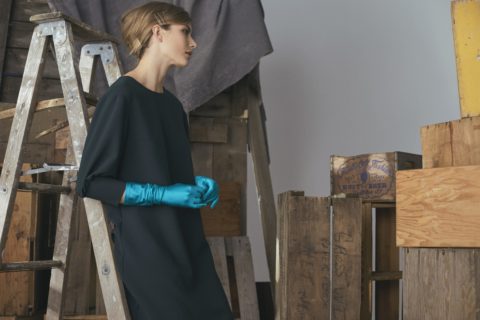Comrags Celebrates 35 Years in Fashion
Designers Joyce Gunhouse and Judy Cornish co-design everything in their downtown-Toronto studio.
In 1983, after meeting in Ryerson University’s fashion arts program, Comrags co-designers Joyce Gunhouse and Judy Cornish pooled their cash to stage a fashion show at Toronto after-hours club Voodoo. As the brand they launched—with “leggings, skimpy skirts and little-boy bathing suits that we expected people to wear to clubs”—celebrates its 35th anniversary, the designers admit there was no plan. “We probably thought we’d give it two years,” says Gunhouse.
Sportswear, as it was known then, was pioneered by vanguard women like Claire McCardell, Bonnie Cashin and Anne Klein, but in 1983, fashion was still a boys’ club. “That’s one of the biggest changes,” says Cornish, recalling the time before Comme des Garçons had established a cult following or Donna Karan had set up her own brand. “Now, women are as much if not more interested in what other women think; then, it was still very much male designers setting the taste. Even in Canada, it was Leo Chevalier and Simon Chang and Mr. Jax. All men! That was the landscape.”
Just like in 1983, Gunhouse and Cornish co-design everything and are hands-on in every aspect of the business (from pattern-making to garment production) in their downtown-Toronto studio. The clothes remain proudly “made in Canada,” where, thanks to a handful of longtime stockists from Vancouver to St. John’s, N.L., they can be found from coast to coast. Their enduring personal friendship and professional partnership have encompassed research trips to places like Paris as well as raising their respective families.
Over the years, family and friends have gotten involved. The Comrags flagship boutique interior, for example, was created by award-winning television production designer Rocco Matteo, who happens to be Gunhouse’s husband. For roughly 20 years, Gunhouse’s sister Judy has managed the Toronto store, and sister Susan has worked with Comrags for close to 30 years. Head seamstress Loan, who has worked with them since the very beginning, is part of the extended family, too.
The sources of inspiration in any given season are eclectic. “I’m a scavenger for weird and random details of how things are put together,” says Cornish, who scours thrift stores for vintage clothing and textiles. A quirky pocket feature might be pilfered from an apron—or messy pleats stitched down to mimic a skirt tangled by the wind.
What’s “typical Comrags” depends on when you bought your first piece. Was it during the 1980s of one-size-fits-all Lycra separates and oversized coats? Or perhaps it was early 1990s grunge, when the brand was known for flirty florals and bias-cut slips—or the later menswear-inspired suits and ’40s-style crepe midi-dresses. Women who came of age in the 2000s might associate Comrags with the proportion and contrast of nipped jackets and tunics creatively layered over cropped trousers—or feminine frocks worn with mannish brogues.
Fluency in fashion history allows Gunhouse and Cornish to play with their brand’s design vernacular from season to season. Comrags is where elements of style are juxtaposed with subversive wit. It’s less a garment than an attitude.
“Part of our success is that we have fans who bought us when they were younger and we’ve grown with them,” ventures Gunhouse. “They bought at a time when they were becoming who they are. Often, it was when they first felt themselves as cool.”








